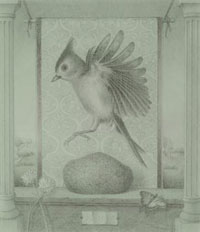Silverpoint, or metalpoint when one refers to all the metals potentially used to make marks, seems to be a drawing medium which elicits instant interest in everyone to whom one talks about it. It always surprises me how its mysterious attraction remains intact.
I was recently reminded of this attraction when I mentioned to a Spanish friend that I draw in silver, and also gold, copper, etc. What had been interest in what I said became intense attention as I was carefully quizzed about just was this drawing medium.
Telling the story of how the monks started using lead for their lines in handwritten manuscripts and outlines for illumination from possibly the 8th century onwards, as demonstrated by the Lindesfarne Gospels, brings home the antiquity of this medium. The fact that, later, all the great artists whose names everyone knows - Leonardo da Vinci, Raphael, Lorenzo di Credi, Albrecht Durer - all used metalpoint, especially silverpoint, elicits even more interest.
Rogier van der Weyden - Head of the Virgin
Leonardo da Vinci - Studies of Horses
Raphael - Study for St. Thomas 1502-03
Graphite's appearance helping to decrease the popularity and use of drawing in metal is another surprise. Most people have never even thought about the origins and history of the "lead pencils" they use so often.
The virtual disappearance of metalpoint after Rembrandt's few silverpoint drawingsand Judith Leyster's botanical studies in silver are the next chapter in the story I find myself frequently telling about this medium.
Rembrandt - His fiancee, Saskia, 1733
When Cennino Cennini's manuscript of the Il Libro dell' Arte was re-found in the early 19th century in an Italian archive, and people learned once more about silverpoint from Cennini talking of this medium and how to prepare all the materials to draw in metalpoint, there was a renewal of the medium.
Now, in the early 21st century, after spluttering interest during the 20th century, there seems to be another renaissance in metalpoint, despite its relentless aspects of narrow value range, impossibility to erase marks and slow development of the work. With increased interest in drawing media in general, it is natural that metalpoint be one of the voices in the drawing chorus. There is a wonderful diversity in the work being done, from classical approaches to very experimental work. Realistic (helped by the very fine lines which characterise drawing with a metal stylus) approaches are complemented by strictly abstract work, but share the shimmering, discreetly elegant characteristics of these drawings.
Tom Mazzullo - Elliptical, 2011 (courtesy of the artist)
Lori Field - Ducky in Pinky Talky Town (courtesy of the artist)
Koo Schadler - Titmouse (courtesy of the artist)
Jeannine Cook - Havre de Grace, gold and silverpoint
Jeannine Cook - Ariadne's Thread II - Pine Bark, silverpoint
Metalpoint's allure, a medium that to me seems very much of our contemporary often sleek and understated approach to art and design, comes from its lustrous appearance and also, as I keep finding, its mystery of origins and history. I must admit, I thoroughly enjoy telling people about this drawing medium, and I suspect that my hundred or so fellow metalpoint artists also relish their role of ambassador for this special way of drawing.









